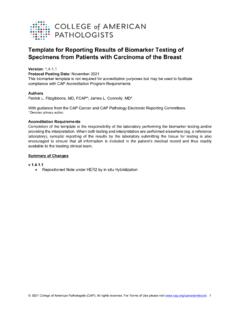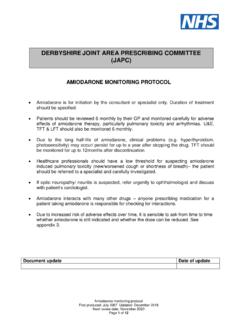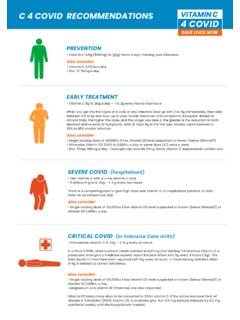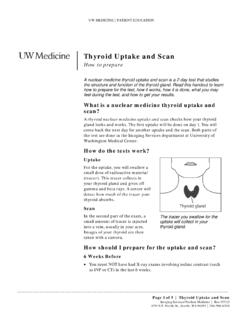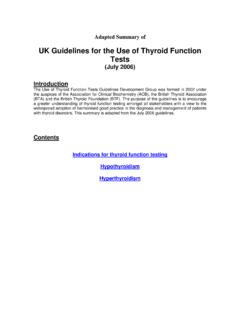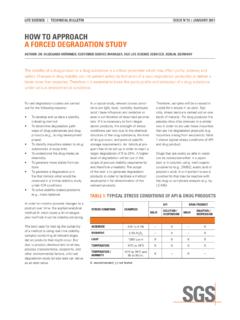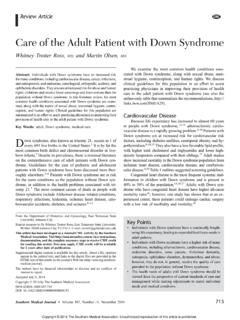Transcription of Laboratory Procedure Manual
1 Laboratory Procedure Manual Analyte: Sodium, Potassium, Chloride (Electrolytes) Matrix: Urine Method: Roche Ion-Selective Electrode Method No: Revised: March, 2016 As performed by: Nutritional Biomarkers Branch Division of Laboratory Sciences National Center for Environmental Health Contact: James L. Pirkle, , Director, Division of Laboratory Sciences Important Information for Users CDC periodically refines these Laboratory methods. It is the responsibility of the user to contact the person listed on the title page of each write-up before using the analytical method to find out whether any changes have been made and what revisions, if any, have been Release Data Set Information This document details the Lab Protocol for testing the items listed in the following table.
2 Data File Name Variable Name Description HULT_H_RSSLT_H_RU1LT_H_RU2LT_H_R URHCLMSI Chloride, Urine AM Collection (mmol/L) URHKMSI Potassium, Urine AM Collection (mmol/L) URHNAMSI Sodium, Urine AM Collection (mmol/L) URHCLESI Chloride, Urine PM Collection (mmol/L) URHKESI Potassium, Urine PM Collection (mmol/L) URHNAESI Sodium, Urine PM Collection (mmol/L) UR1 NASI Sodium, Urine 1st Collection (mmol/L) UR1 KSI Potassium, Urine 1st Collection (mmol/L) UR1 CLSI Chloride, Urine 1st Collection (mmol/L) UR2 NASI Sodium, Urine 2nd Collection (mmol/L) UR2 KSI Potassium, Urine 2nd Collection (mmol/L) UR2 CLSI Chloride, Urine 2nd Collection (mmol/L) SSUNASI Sodium, Urine MEC Collection (mmol/L) Sodium, Potassium, & Chloride in Urine CollectionsNHANES 20141 SSUKSI Potassium, Urine MEC Collection (mmol/L) SSUCLSI Chloride, Urine MEC Collection (mmol/L) Sodium, Potassium, & Chloride in Urine Collections NHANES 20142 1.
3 Summary of Clinical Relevance and Test Principle A. Clinical relevance Sodium measurements are used in the diagnosis and treatment of aldosteronism (excessive secretion of the hormone aldosterone), diabetes insipidus (chronic excretion of large amounts of dilute urine, accompanied by extreme thirst), adrenal hypertension, Addison s disease (caused by destruction of the adrenal glands), dehydration, inappropriate antidiuretic hormone secretion, or other diseases involving electrolyte imbalance. Potassium measurements are used to monitor electrolyte balance in the diagnosis and treatment of disease conditions characterized by low or high blood potassium levels. Chloride measurements are used in the diagnosis and treatment of electrolyte and metabolic disorders such as cystic fibrosis and diabetic acidosis.
4 The urine electrolytes sodium, potassium and chloride are principally used as nutritional indicators in healthy persons. They are infrequently measured in clinical settings, and when they are it is usually in Intensive/Critical care units. Their measured values are not diagnostic of any disease in and of themselves; rather they can in certain special situations be used to help support the diagnosis of several somewhat rare clinical conditions. The more important use of urinary electrolyte data is for public health studies. Urine sodium data is an important biomarker of dietary sodium intake. B. Test principle An Ion-Selective Electrode (ISE) makes use of the unique properties of certain membrane materials to develop an electrical potential (electromotive force, EMF) for the measurements of ions in solution.
5 The complete measurement system for a particular ion includes the ISE, a reference electrode, and electronic circuits to measure and process the EMF to give the test ion concentration. The type of ISE used on the Hitachi ISE Module(s) is classified as liquid/liquid junction type. The sodium [1, 2] and potassium [3] electrodes are based on neutral carriers and the chloride [4] electrode is based on an ion exchanger. For determinations on the ISE Module(s), the sample is diluted 1:31 and a single 15 uL sample is taken for the three assays. 2. Safety Precautions Consider all specimens potentially positive for infectious agents including HIV, hepatitis B and hepatitis C. We recommend that the hepatitis B vaccination series for all the analysts working with whole blood and/or serum.
6 Observe universal precautions; wear protective gloves, Laboratory coats, and safety glasses during all steps of this method. Discard any residual sample material by autoclaving after analysis is completed. Place all disposable plastic, glassware, and paper (pipette tips, vials, gloves, etc.) in a biohazard autoclave bag and keep these bags in appropriate containers until sealed and autoclaved. Wipe down all work surfaces with 10% bleach solution when work is finished. Handle acids and bases with extreme care; they are caustic and toxic. Handle organic solvents only in a well-ventilated area or, as required, under a chemical fume hood. Reagents and solvents used in this study are listed in Section 6. Material safety data sheets (MSDSs) for all chemicals are readily accessible as hard copies in the lab.
7 Sodium, Potassium, & Chloride in Urine Collections NHANES 201433. Computerization and Data System Management A. During sample preparation and analysis, samples are identified by their sample ID. The sample ID is a number that is unique to each sample that links the Laboratory information to demographic data recorded by those who collected the sample. B. Calculation of Sodium, Potassium and Chloride concentrations are accomplished with the software on the Roche Mod P and generated data are transferred to the DLS network where it is saved. The results file is imported into a database for review of the patient data, statistical evaluation of the QC data, and approval of the results . See SOP Computerization and Data System Management for a step-by-step description of data transfer, review and approval. C. NHANES data is transmitted electronically on a regular basis (approximately weekly for 3-week turnaround analytes).
8 Abnormal values are confirmed by the analyst, and codes for missing data are entered by the analyst and are transmitted as part of the data file. NCHS makes arrangements for the abnormal report notifications to the NCHS Survey Physician. D. The data file and results file from the instrument workstation are typically backed up daily to the Roche/Hitachi USB Memory Stick for long-term storage. This is the responsibility of the analyst under the guidance of the project lead person. Files stored on the DLS network are automatically backed up nightly by ITSO support staff. 4. Specimen Collection, Storage, and Handling Procedures: Criteria for Specimen Rejection A. Use serum free of hemolysis and gross lipemia, collected by standard venipuncture technique [5]. Only lithium heparin plasma may be used.
9 Do not allow serum to remain on the cells after centrifugation. Potassium from the red cells will diffuse into the serum, giving falsely elevated results . Urine should be collected without using preservatives and stored refrigerated during collection [6]. B. The appropriate amount of serum/plasma/urine is dispensed into a Nalge cryovial or other plastic screw-capped vial labeled with the participant's ID. C. Specimens collected in the field are frozen, and then shipped on dry ice by overnight mail. Frozen samples are stored at -70 C. When separated from erythrocytes and stored tightly stoppered at 2-8 C, chloride content is stable for several days [6]. Sodium and potassium are stable for 2 weeks at 15-25 C or 2-8 C [7]. D. Centrifuge samples containing precipitate before performing the assay.
10 Grossly lipemic specimens should be cleared by ultracentrifugation. Turbid urine samples should be cleared by centrifugation. E. A 500- L sample of serum/plasma/urine is required to allow for repeat analyses; a volume of 150 L is required for pipetting into the sample cup for analysis. F. Ensure patient samples, calibrators and QC are at ambient temperature (20-25 C) before measurement. G. Because of possible evaporation effects, all samples, calibrators, and QC on the analyzer should be measured within 2 hours. H. Specimens generally arrive frozen. Refrigerated samples may be used provided they are kept cold and brought promptly (within 2 hours) from the site of collection. Sodium, Potassium, & Chloride in Urine Collections NHANES 20144I. Specimen handling conditions are outlined in the DLS Policies and Procedures Manual .










